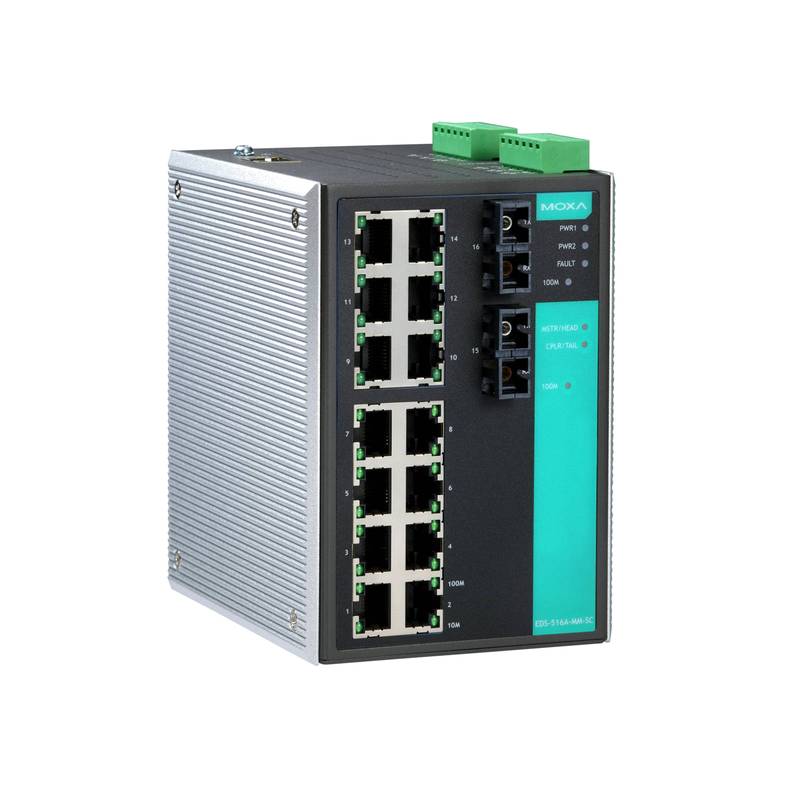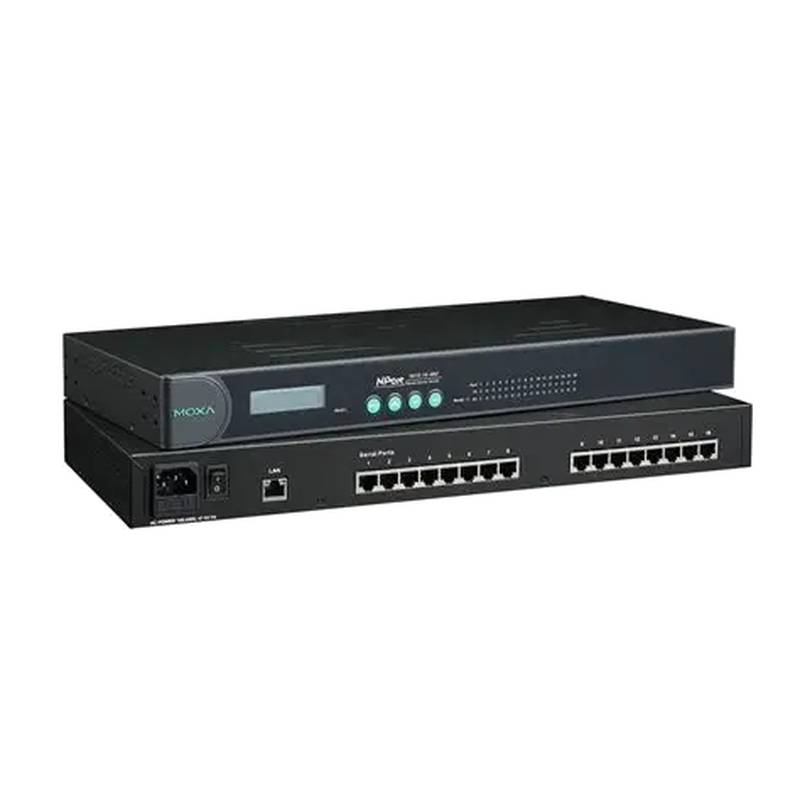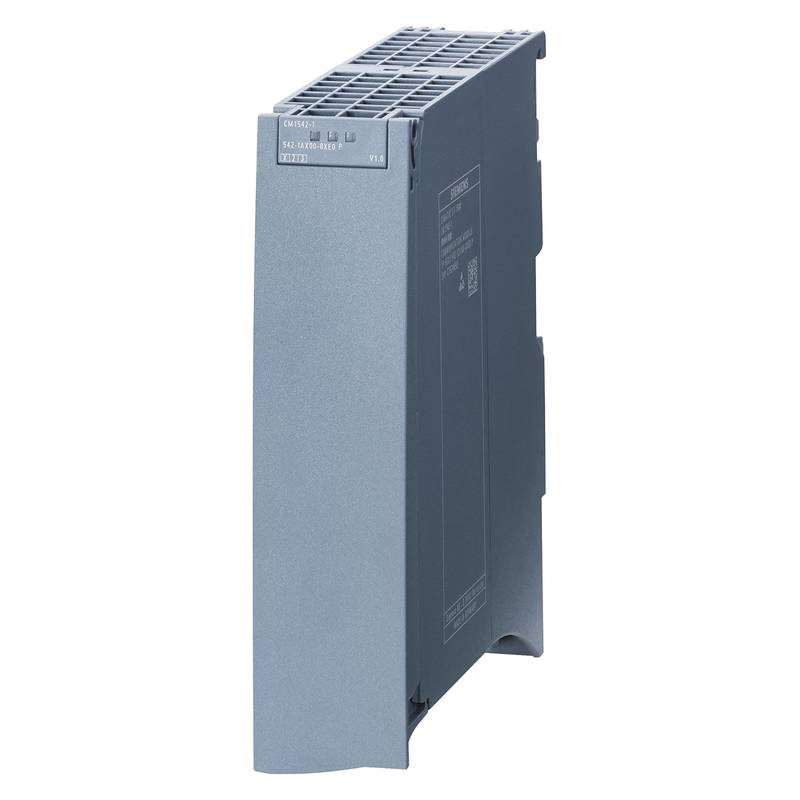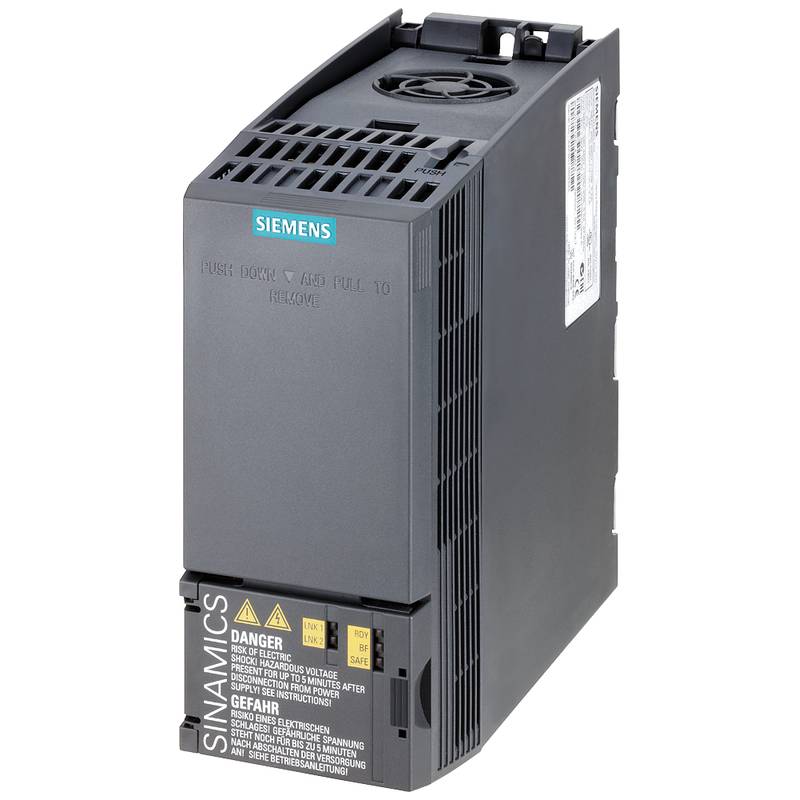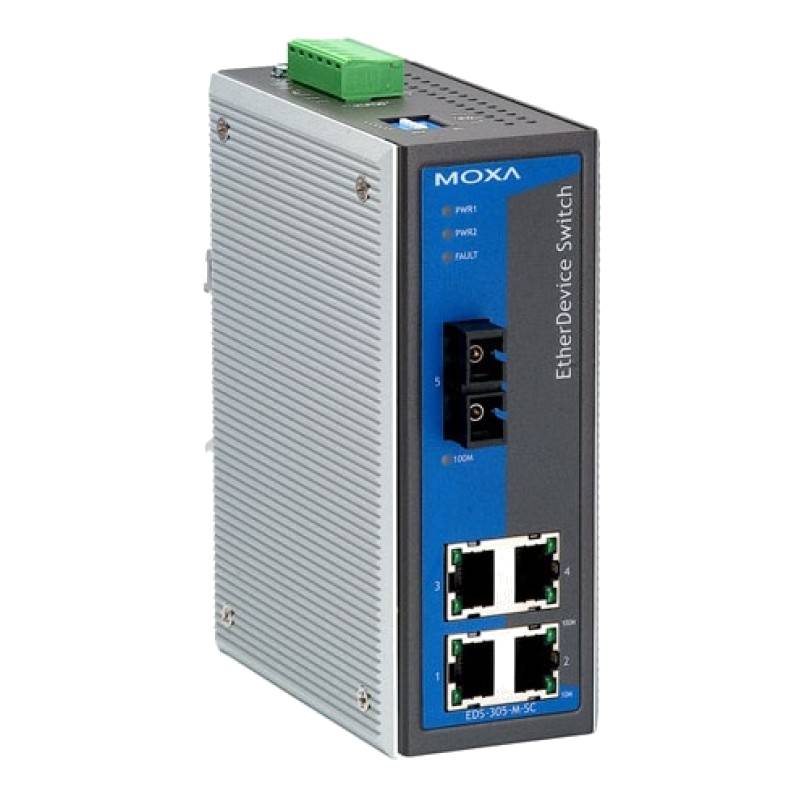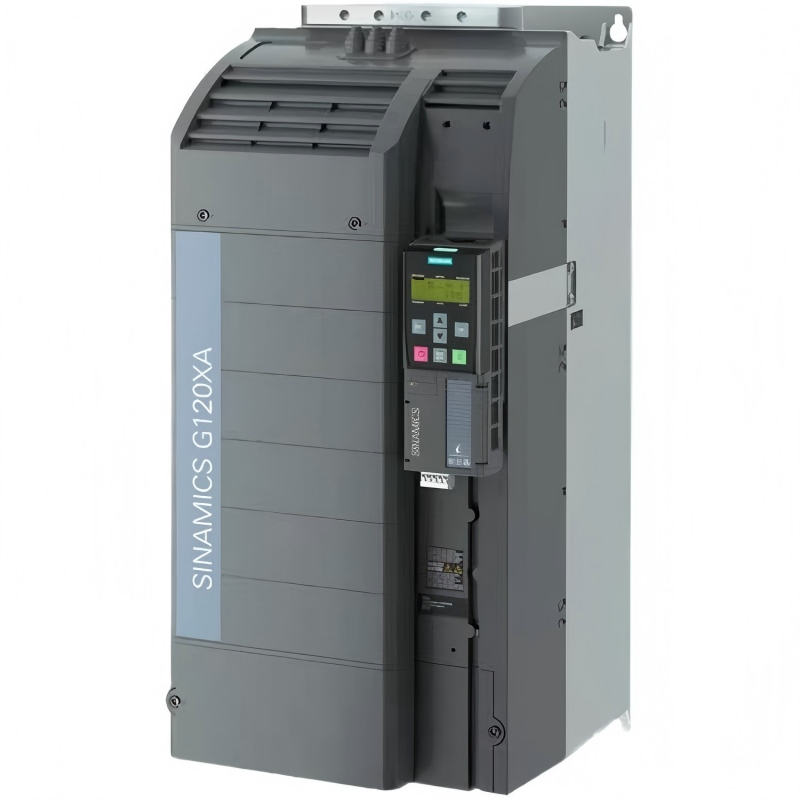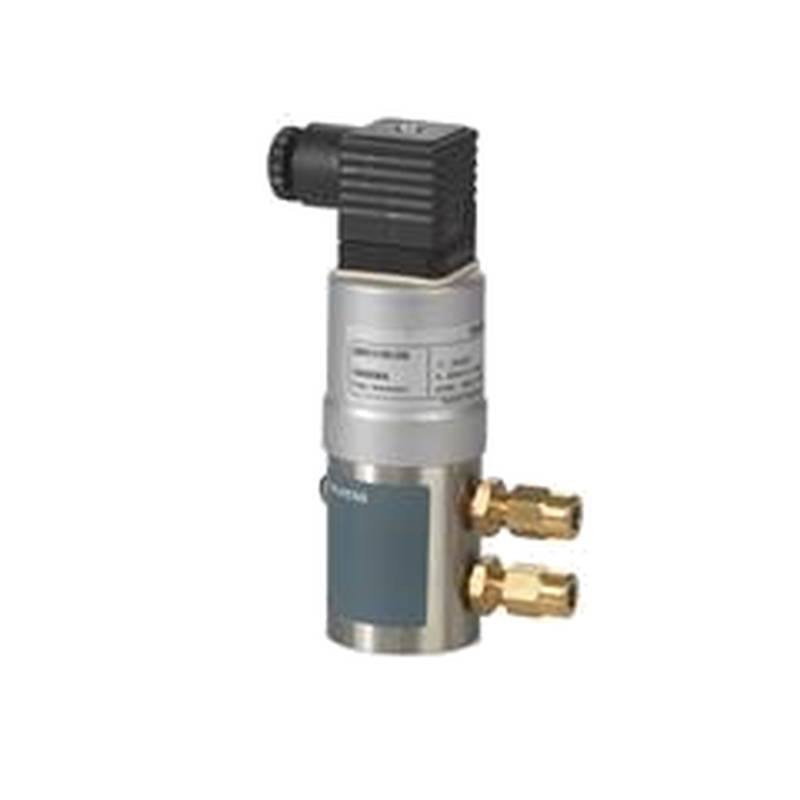
The Moxa EDS-516A-MM-SC is a robust 16-port managed industrial Ethernet switch designed for demanding environments, offering a high-density solution for network connectivity. Its key advantages include advanced network redundancy with Turbo Ring and Turbo Chain technologies, ensuring network uptime and resilience. The switch features 16 multi-mode SC fiber ports, providing extended transmission distances crucial for industrial automation, power utilities, and transportation sectors. Its operating temperature range of -40 to 75°C makes it suitable for harsh conditions, and its DIN-rail mounting capability facilitates easy integration into industrial cabinets. Technical parameters showcase its reliability, with an MTBF of over 400,000 hours and support for 10/100BaseT(X) Ethernet speeds.
Product Specifications
| Feature | Specification |
| :---------------------- | :-------------------------------------------- |
| Model | Moxa EDS-516A-MM-SC |
| Ports | 16 x 10/100BaseT(X) auto-MDI/MDI-X RJ45 ports, 16 x 100BaseFX multi-mode SC fiber ports |
| Fiber Connector Type | SC |
| Fiber Wavelength | 1310 nm |
| Fiber Distance | Up to 2 km |
| Power Input | 24 VDC (12/24/48 VDC, 18-30 VAC) |
| Operating Temperature | -40 to 75°C (-40 to 167°F) |
| Storage Temperature | -40 to 85°C (-40 to 185°F) |
| Humidity | 5% to 95% RH (non-condensing) |
| MTBF | > 400,000 hours |
| Mounting | DIN-rail, Wall-mount (with optional kit) |
| Management | Web, Telnet, Console, SNMP, Moxa IMC |
| Redundancy | Turbo Ring (Ring/Chain), STP/RSTP |
Core Features & Market Positioning
The Moxa EDS-516A-MM-SC distinguishes itself in the industrial Ethernet market through its high port density combined with robust fiber optic connectivity, a combination ideal for expanding networks without compromising physical space. Its advanced Turbo Ring and Turbo Chain redundancy protocols offer millisecond recovery times, far surpassing standard Spanning Tree Protocol (STP) and Rapid Spanning Tree Protocol (RSTP) in critical applications where network interruption is not an option. This focus on reliability and performance positions the EDS-516A-MM-SC as a premium choice for systems integrators and network engineers building fault-tolerant industrial networks. The multi-mode SC fiber ports specifically address the need for reliable, high-speed data transmission over moderate distances within industrial facilities, offering immunity to electromagnetic interference. Moxa's established reputation for industrial-grade hardware further solidifies its market standing, providing assurance of longevity and support.
Key Application Scenarios
This high-density, multi-mode fiber switch is indispensable in scenarios demanding extensive network reach and resilience. In power automation, it facilitates robust communication between substations, control centers, and field devices, ensuring reliable data flow for SCADA systems even across electrically noisy environments. For transportation systems, such as railway signaling or traffic control networks, the EDS-516A-MM-SC provides the necessary connectivity for distributed sensors and control units, benefiting from fiber's immunity to interference and extended range. Manufacturing and factory automation also heavily rely on this switch for connecting numerous PLCs, HMI devices, and robotic systems across large production floors where copper cabling limitations are overcome by multi-mode fiber. Its ability to handle high port counts efficiently makes it a cornerstone for building scalable and dependable industrial networks in these demanding sectors.
Practical System Integration Guidance
Integrating the Moxa EDS-516A-MM-SC into an existing industrial network is straightforward due to its plug-and-play capabilities for basic operation and comprehensive management features. For initial setup, connect power to the designated terminals (typically 24 VDC) and establish a console connection via the RJ45 console port using a serial cable and terminal emulation software like PuTTY. Network configuration, including IP addressing, VLANs, and redundancy protocols, can be accessed through a web browser or Telnet interface once the switch is powered and connected to the network. For fiber connections, ensure compatibility of the multi-mode fiber optic cables and transceivers (SC connectors) with the switch's 100BaseFX ports, maintaining proper bend radius and clean connectors to ensure signal integrity over the specified 2 km distance. The DIN-rail mounting system simplifies physical installation within control cabinets, allowing for a secure and organized deployment.
Operation and Risk Mitigation
Operating the Moxa EDS-516A-MM-SC requires adherence to industrial networking best practices to ensure longevity and prevent failures. It is crucial to maintain the operating temperature within the specified -40 to 75°C range and ensure adequate ventilation within the enclosure to prevent overheating, which is a primary cause of electronic component failure in harsh environments. Power surge protection on the input voltage supply is also recommended, as industrial power fluctuations can destabilize operation. Regular firmware updates, managed through Moxa's management tools or standard SNMP, can patch security vulnerabilities and improve performance. Troubleshooting often involves checking link status LEDs, utilizing built-in diagnostic tools accessible via the management interface, and verifying fiber optic cable connections for cleanliness and proper seating.
Scalability & Long-Term Value
The Moxa EDS-516A-MM-SC is designed for scalability and offers significant long-term value within industrial automation infrastructures. Its high port density allows for the connection of a large number of devices, accommodating network growth without requiring additional switch chassis, thus optimizing cabinet space and cost. The switch’s support for industrial protocols and its compatibility with a wide range of Moxa’s other industrial networking devices and management software, such as Moxa Industrial Managed Switches (IMC), ensures seamless integration into larger, heterogeneous network environments. Furthermore, its robust build quality and focus on reliability contribute to a lower total cost of ownership by minimizing downtime and maintenance requirements, making it a sound investment for future-proofing industrial networks and supporting the transition towards Industrial Internet of Things (IIoT) and smart factory initiatives.
FAQs
What is the maximum distance for the fiber optic connections on the Moxa EDS-516A-MM-SC?
The Moxa EDS-516A-MM-SC utilizes multi-mode fiber optic cables with SC connectors, supporting transmissions up to 2 kilometers. This range is ample for most industrial facility interconnections, such as linking different building sections or control cabinets within a large plant. Ensuring the use of appropriate multi-mode fiber (e.g., 50/125 µm or 62.5/125 µm) is vital for achieving this specified distance and maintaining signal integrity.
How do I configure network redundancy on the Moxa EDS-516A-MM-SC?
The switch supports advanced redundancy protocols like Moxa's proprietary Turbo Ring and Turbo Chain, along with standard STP/RSTP. Configuration is typically performed via the web interface, Telnet, or console port. You can define the ring or chain topology, set master/slave roles, and configure parameters for rapid network recovery in case of link failures.
What industrial environments is the Moxa EDS-516A-MM-SC best suited for?
This switch excels in harsh industrial settings such as power substations, manufacturing plants, and transportation systems. Its wide operating temperature range of -40 to 75°C, along with its rugged design and immunity to electromagnetic interference provided by fiber optics, makes it ideal for demanding applications. It is built to withstand vibrations, shock, and extreme environmental conditions common in these sectors.
Can I use the Moxa EDS-516A-MM-SC with different types of fiber optic cables?
The EDS-516A-MM-SC is specifically designed for multi-mode fiber optic cables terminated with SC connectors. While it supports common multi-mode fiber types (like 50/125 µm and 62.5/125 µm), it is not compatible with single-mode fiber. Using the correct cable type and ensuring clean connectors are essential for optimal performance and distance.
What management features are available for the Moxa EDS-516A-MM-SC?
The EDS-516A-MM-SC offers comprehensive management capabilities. This includes remote configuration and monitoring via web interface, Telnet, or SNMP. It also supports Moxa’s own management software (like Moxa IMC) for centralized control of multiple devices. A console port is provided for direct, out-of-band management and initial setup.
Does the Moxa EDS-516A-MM-SC support Power over Ethernet (PoE)?
No, the Moxa EDS-516A-MM-SC does not natively support Power over Ethernet (PoE) on any of its ports. It is designed as a data connectivity switch, focusing on high-density Ethernet and fiber integration. Power to the switch itself is supplied via its DC power input terminals.
How does Turbo Ring redundancy work on this switch?
Turbo Ring is Moxa's proprietary redundant Ethernet technology that provides a fault-tolerant ring topology with very fast recovery times, typically under 300 ms. It allows multiple switches to be interconnected in a ring, and if a link fails, traffic is automatically rerouted through the remaining path, ensuring continuous network operation.
What are the advantages of using fiber optic ports over copper Ethernet ports in industrial settings?
Fiber optic ports offer significant advantages, including immunity to electromagnetic interference (EMI), which is prevalent in industrial environments. They also support much longer transmission distances compared to copper Ethernet and provide higher bandwidth capabilities. This makes them ideal for connecting equipment across large facilities or in electrically noisy areas.
How can I troubleshoot connectivity issues with the Moxa EDS-516A-MM-SC?
Start by checking the Link/Act LEDs on both the copper and fiber ports to verify physical connections. Ensure proper cable integrity and clean connectors. Utilize the switch’s web or CLI interface to check port status, error counters, and device logs. If redundancy is configured, test the failover mechanism to confirm it is functioning correctly.
What is the expected lifespan or MTBF for the Moxa EDS-516A-MM-SC?
The Moxa EDS-516A-MM-SC is engineered for industrial reliability and boasts a Mean Time Between Failures (MTBF) of over 400,000 hours. This high MTBF indicates exceptional robustness and a long operational lifespan, even under demanding continuous operating conditions. This contributes to reduced maintenance costs and enhanced system uptime.














